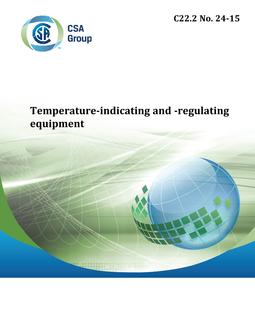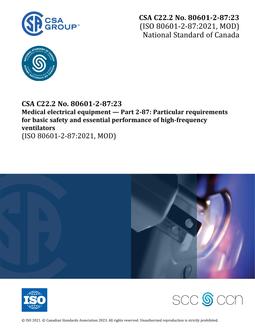
CSA C22.2 NO. 24-15
Preface
This is the ninth edition of CSA C22.2 No. 24, Temperature-indicating and -regulating equipment. It is part of a series of Standards issued by CSA Group under Part II of the Canadian Electrical Code. It supersedes the previous editions, published in 1993, 1987, 1981, 1972, 1965, 1963, 1955, and 1935. The following revisions have been made in this edition (clause numbers refer to this edition of the Standard unless otherwise noted): – clarification of Clauses 1.2 and 1.3 of the Scope; – reference publications list in Clause 2 expanded and updated; – definitions added to Clause 3; – construction provisions clarified in Clauses 5.1.8 and 5.1.9; – Clauses 5.2.6.11 and 5.2.6.12 expanded to clarify investigation; – provisions applicable to mercury removed from Clause 5.4; – Clause 5.5 revised and expanded; – Clause 5.10.15 added; – Clause 5.11 expanded to include additional provisions for transformers; – Clause 5.12.5 added to clarify capacitors used in applications that require X and Y classifications; – Clause 5.13 rewritten to define surge suppressors and optical devices; – provisions applicable to mercury switches (Clauses 4.14.3 and 4.14.4 in the previous edition) deleted because mercury switches are no longer acceptable; – new clauses added to the construction provisions in Clause 5 as follows:
- – Clause 5.22, Power supplies; – Clause 5.23, Motors; – Clause 5.24, Telecommunication network equipment; – Clause 5.25, Communication applications; – Clause 5.26, Temperature controls provided with a ground fault circuit interrupter; – Clause 5.27, Electronic gas/air ratio controls; – Clause 5.28, Thermal cut-offs; – Clause 5.29, Thermistors; and – Clause 5.30, Room thermostats;
– Clause 6.1(m) added; – Clause 7.6.1 clarified; – Clause 7.7.21 added for controls provided with manual actions; – Clauses 7.9.2.1, 7.9.2.2, and 7.9.2.3 added for clarity; – Clause 7.9.9 added for clarity; – Clause 7.10.10 added for clarity; – Clause 7.11.6 revised; – Clause 7.16.4 added to address damp actuators; – Clauses 7.21 revised to remove references to mercury; – Clause 7.25 updated and title changed from “Transient-voltage surge suppression” to “Surge immunity test”; – Clauses 7.26 to 7.29 added; – Clause 11 added; – Table 4 updated with additional tests: surge immunity, short-circuit, and abnormal; – Table 6 updated (Items 3, 4, and 7 to 9); – Table 10 updated [Items 3, 4, and 6 to 9 and Notes † and ‡]; – Figure 5 corrected; – Figures 7 and 8 added; – Annex A (normative) added; and – Annex A from the previous edition renamed Annex B. Permission to use extracts from ISO 23552-1:2007, Safety and control devices for gas and/or oil burners and gas and/or oil appliances – Particular requirements – Part 1: Fuel/air ratio controls, electronic type, was provided by the Standards Council of Canada in cooperation with IHS Canada. No further reproduction of this material is permitted without prior written approval from the Standards Council of Canada.
Scope
1.1 This Standard applies to temperature-indicating and -regulating equipment* for voltages up to and including 600 V between conductors and intended for general household and industrial use in nonhazardous locations, in accordance with the Rules of the Canadian Electrical Code, Part I (CEC, Part I). * For convenience, the shorter term “equipment” is sometimes used in this Standard. 1.2 This Standard applies to electrical control equipment for air conditioning, heating, lighting, cooling, refrigeration, cooking appliances, safety controls, and other similar appliance controls. 1.3 This Standard does not apply to dimmers and extra-low-voltage equipment other than safety controls and room thermostats with heat anticipators. 1.4 In this Standard, “shall” is used to express a requirement, i.e., a provision that the user is obliged to satisfy in order to comply with the standard; “should” is used to express a recommendation or that which is advised but not required; and “may” is used to express an option or that which is permissible within the limits of the standard. Notes accompanying clauses do not include requirements or alternative requirements; the purpose of a note accompanying a clause is to separate from the text explanatory or informative material. Notes to tables and figures are considered part of the table or figure and may be written as requirements. Annexes are designated normative (mandatory) or informative (non-mandatory) to define their application.
Product Details
- Edition:
- 9th
- Published:
- 01/01/2015
- ISBN(s):
- 9781771396431
- Number of Pages:
- 114
- File Size:
- 1 file , 2.5 MB
- Product Code(s):
- 2423215, 2423215, 2423215


